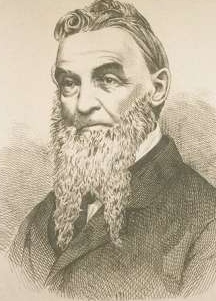Like many rebels, Dr. Robert Nelson (August 8, 1794-March 1, 1873) lived for years as a loyal subject of the British sovereign. In Montreal, his skills as a physician were widely known and sought after. Like his brother Wolfred, he served in the elected assembly along side Louis-Joseph Papineau and argued for popular reforms.
 |
| Portrait of Dr. Robert Nelson in his later years |
Upon his release, Nelson joined the exiled Patriotes in Vermont. Americans showed enormous sympathy for the Patriotes and their cause, as they did with William Lyon Mackenzie and his Patriots in Upper Canada. While Papineau cautioned against further armed insurrection, Robert Nelson wanted a fight. He became the top general of the exiled Patriote army and the president elect of the proposed Republic of Lower Canada. With his American allies, he plotted new attacks on Canada.
Nelson Leads Force Against Canada
Somehow news of the battle plan devised by Bill Johnston and other Patriot leaders in Buffalo in January 1838 made its way to General Robert Nelson encamped in Alburg, Vermont. To him, it made sense to launch a Patriote invasion of Lower Canada near the end of February, while the British were occupied fighting armies led by General Donald McLeod and Admiral Johnston.On February 24, 1838, Patriotes or their American sympathizers broke into the state arsenal at Elizabethtown, New York, (adjacent to Vermont) and made off with 250 rifles.
Four days later, Nelson and 700 armed Canadian and American raiders invaded Lower Canada from Vermont. His men distributed copies of a declaration loosely based on the US Declaration of Independence.
Their Canadian occupation was brief. Over night, about 500 men deserted. A waiting British force had advance notice of the attack and quickly drove Nelson's remaining army back into the US. They were promptly arrested by the US army for breaking the neutrality law, but soon released.
Nelson Creates a Secret Brotherhood
Robert Nelson had made the same mistake as William Lyon Mackenzie and the other Patriot rebel leaders—he had publicly recruited his army and trained troops in plain view. British spies and informers found it easy to keep tabs on the rebel activities and report back to their British masters.Once released from arrest, Nelson decided not to repeat that mistake. He created a secret society dubbed the Frères-Chasseurs with a strict hierarchy and secret oaths modeled after the Masons. Funds rolled in from sympathizers in Lower Canada and the United States.
Nelson's top officers created Frères-Chasseurs lodges throughout Lower Canada as part of a grand plan to launch a populist uprising and attack from American later in 1838.
While Nelson's military efforts never seriously threatened Canada, his creation of the Frères-Chasseurs later became the model for the Hunters, the biggest and mightiest secret society of the Patriot War.

0 comments:
Post a Comment